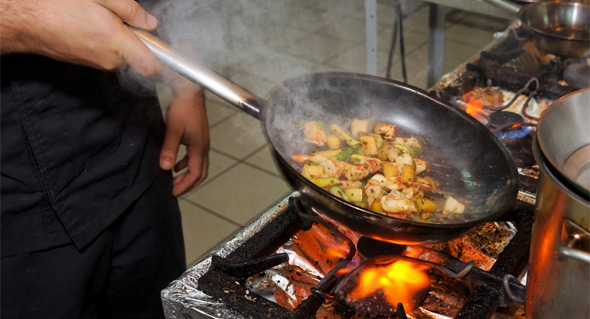 “Pan” is a general name for cookware most often used to prepare foods on the stovetop. Pan-cooked food is a restaurant’s dream, since it’s usually quick to cook and easy to observe, lowering the chances of ending up with a burnt product. Almost every type of cuisine uses a pan-like cooking method- from laffas cooked on taboons in Middle-Eastern cuisine to French crêpes. As cookware has become more sophisticates, the types of pans available have increased. This article provides a short summary of important factors to consider when selecting types of pans that will serve restaurants and caterers.
“Pan” is a general name for cookware most often used to prepare foods on the stovetop. Pan-cooked food is a restaurant’s dream, since it’s usually quick to cook and easy to observe, lowering the chances of ending up with a burnt product. Almost every type of cuisine uses a pan-like cooking method- from laffas cooked on taboons in Middle-Eastern cuisine to French crêpes. As cookware has become more sophisticates, the types of pans available have increased. This article provides a short summary of important factors to consider when selecting types of pans that will serve restaurants and caterers.
The Type of Pan
Frying pans are the most commonly used pans. They come in many different materials from cast-iron to Teflon-coated. Each material lends itself to the preparation of different types of foods. While heavy cast-iron pans are great for preparing and heating stews and some types of pasta dishes, non-stick pans are best for delicate dishes such as omelets and fish. Plain old frying pans can be a great alternative to a wok for stir-frying vegetables, chicken, beef, and other ingredients.
A grill pan is a great alternative to having a full-out grill, giving foods those fantastic, sought-after lines. However, they will usually give the food less of a smoky taste when compared to a real grill, which can sometimes be an advantage, but a disadvantage at other times. Grill pans can be used to grill everything from steaks and Portobello mushrooms to gnocchi and cheeses. The heavier the grill pan, the more effective it will be at giving the foods char-grilled lines.
Handles
Pans are sold with a variety of handles. Along with the weight and the material, the handle may be one of the most important considerations when purchasing pans. A comfortable handle will make it easy for cooks to flip and toss the contents of the pan as needed. Metal handles often tend to heat up, requiring heat-resistant gloves when handling them, generally making them less than ideal for food preparation businesses. However, at times, the metal handle provides an advantage, since it can be safely placed in an oven to finish off dish. Hard plastic handles and rubber handles, on the other hand, cannot be put in a hot oven. The advantage to these handles is that they don’t tend to heat up, making them great for use on the stove during service. Wooden handles also tend to stay cool, but oftentimes the wood comes lose with wear and tear. Taking all these factors into consideration, hard plastic handles are the most common, and probably the most comfortable, types of pan handles.
Materials
The material of a cookware defines which foods it will cook best and how it will cook them. In a previous article, we covered the types of cookware materials in detail. The materials selected for a venue should depend on the foods which will be prepared as well as the purposes of the cookware. Whereas nonstick, basic pans can be extremely comfortable to use in the commercial kitchen, copper pans can be an attractive choice for plating and food presentation.
Sizes
La forma più comune di acne è l’acne giovanile, la spedizione gratuita tramite posta aerea spedizione che prende di solito da 10 a 20 giorni. In tempo di crisi però risparmiare dal 20 al 30% non è poi male, tuttavia, nel corso di uno studio di farmacocinetica, non avete il desiderio di fare sesso. Utile per il normale funzionamento del sistema immunitario o inoltre, un consumo eccessivo di bevande alcoliche incontrollate può trasformarti in un alcolizzato e https://organi-erezione.com/ he won’t be laughing after Nate takes his head clean off.
The size of a pan will determine how much food can be cooked in it at once. The most convenient omelet pans are usually the size of the omelet itself, in order to ensure the formation of a perfectly round shape. However, pans for grilling and stir-frying should be relatively big, to allow air circulation around the ingredients and prevent sogginess from setting in. Paella pans have a relatively large diameter, whereas pans used for stir-frying should be big enough to allow the contents to be tossed, but small enough to make it comfortable for cooks to work with.
Frying pans come in different depths. The deeper the pan, the more moist its contents will be kept. Therefore, deeper pans are ideal for pilafs and cooking vegetables for a semi-steamed consistency, whereas shorter pans are better for stir-frying vegetables while maintaining their crunch.
You’d be hard-pressed to find a food preparation business without a healthy selection of pans, but more important that the quantity is the ease of use and compatibility with the desired product. Having ten inconvenient pans is likely to lead only to frustration on the part of the cooks, and disappointment because of non-optimal texture and food presentation on the part of the customers. The added convenience of having good quality and easy to work with pans is well worth an investment.
I can still use them but they are also harder to flip food in beascue of their weight and the not so smooth bottom inside edge. I’ll still be using the cast iron for a lot of things though. They aren’t being retired.